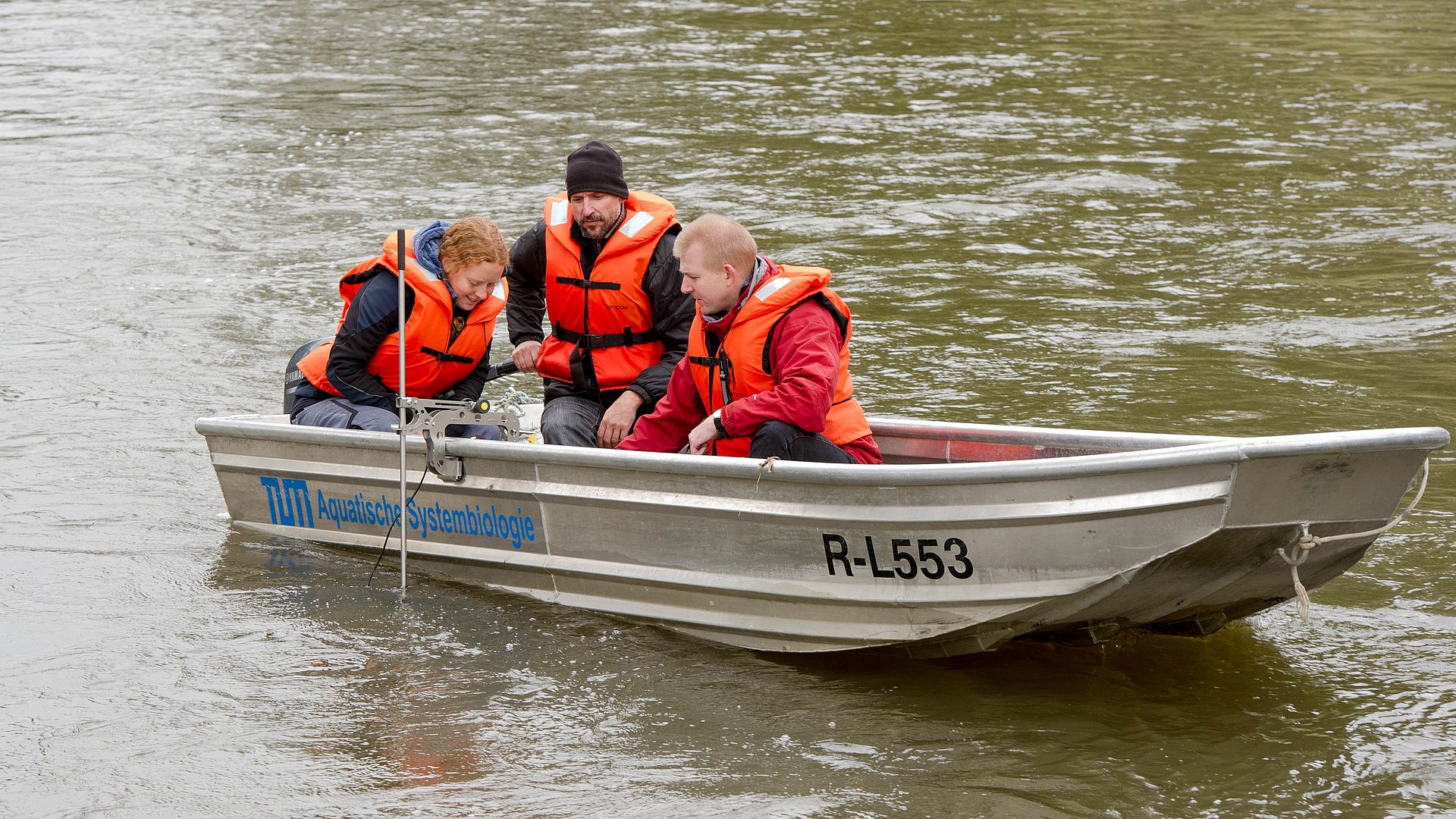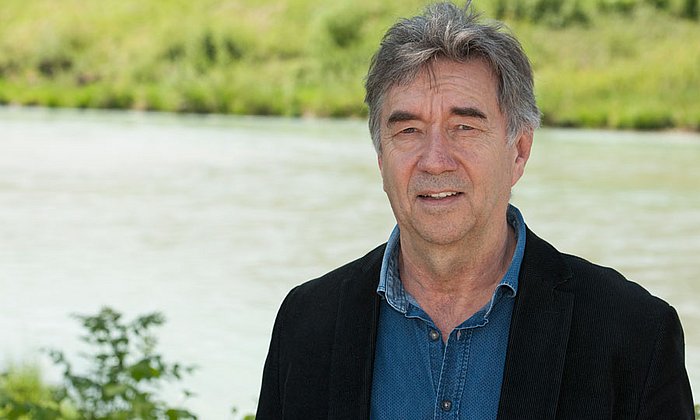Complex investigation of new hydropower plants
Are there hydroelectric power plants that are fish-friendly?

Hydroelectric power plants contribute to a sustainable energy supply, and in the sense that they are low emission, they are also climate-friendly. However, they significantly influence the habitat of fish and other creatures in flowing waters. Jürgen Geist, Professor of Aquatic Systems Biology at the TUM, and his team have been investigating the effects of hydroelectric power plants on downstream-moving fish as well as their impact on aquatic habitats since 2014.
So far, the research team has analyzed seven power plants in Bavaria, which utilize four different technologies, both modern and traditional.
Assessing fish damage and the quality of the aquatic habitat
In order to find out whether fish are being harmed by hydroelectric plants, Professor Geist’s team set up nets downstream from the turbines, overflows, and fish passes in which more than 70,000 fish were caught. The researchers investigated whether and how fish were injured and their mortality rates resulting from such injuries. Approximately 8,500 fish were additionally x-rayed to obtain indications of internal injuries.
In addition, Professor Geist’s team also investigated the composition of the aquatic biocoenoses (fish, invertebrates, aquatic plants, algae) and environmental factors including temperature, dissolved oxygen and pH, in the river upstream and downstream from the hydropower plants.
New hydropower plants are not always better for fish
“The mortality rates at plants with modern technologies were not always lower than at the conventional plants,” reports Professor Geist in the results of his extensive study. It had been assumed that modern plants, such as hydroelectric power screws or power plants which use VLH (that means “very low head”) turbines would protect fish better because these turbines rotate slowly, allowing fish to swim through them, and were thus considered “fish compatible”.
However, the study shows that there is no plant and turbine technology that protects fish better than others. Instead, animal welfare depends on how the technologies are used, which species are present, and which conditions can be found at the respective locations.
VLH turbines, such as those installed at the research site Au at the Iller river, caused “relatively little damage”, says Professor Geist. However, it should be noted that fish survival was significantly reduced with this type of turbine at a different site that has a drop height of four meters.
Whether the plant is running at full load or partial load also effects the welfare of the fish. The empirical studies have shown that grayling and brown trout are more likely to pass the power plant safely when the VLH turbine is operated at high load rather than at low load.
Optimizing evasion possibilities for fish
The majority of the fish population, especially small fish, followed the main current and were not prevented from passing through the turbine rooms by fish protection rakes. The bypasses created at the power plants, where fish can swim around the turbines as they migrate upstream, are not used by most of the animals for the descent.
The studies also found that eel tubes are rarely used. To protect the eel in its natural distribution area in Bavaria (complete Main catchment area), the scientists suggest opening the flushing gates in the weirs, which let branches or larger alluvial deposits pass through, by ten to 20 centimeters during the main migration periods at night in the fall. According to observations, eels clearly prefer to take advantage of this opportunity to move downstream.
Improvement of river habitats
The scientists also took a close look at the ecological water conditions around the plant. “The negative effects of the interruption of the flowing water by the transverse structures should be compensated for in the best possible way. We recommend that replacement habitats for fish and other aquatic creatures be created and that areas should be restored to nature whenever possible”, says Geist.
He goes on to say, “the results of the study were discussed on site with all parties involved at each study site. As a result, improvements have already been worked out.” The multifaceted investigation now offers a broad catalog of influencing factors that can help in the further planning of power plants or in re-approval.
Mueller M, Knott J, Pander J, Geist J (2022) Experimental comparison of fish mortality and injuries at innovative and conventional small hydropower plants. Journal of Applied Ecology. DOI: 10.1111/1365-2664.142
Geist J (2021) Green or red: Challenges for fish and freshwater biodiversity conservation related to hydropower. Editorial, Aquatic Conservation: Marine and Freshwater Ecosystems. 31: 1551–1558. DOI: 10.1002/aqc.3597
“Fish-ecological monitoring at innovative hydropower plants”: In the Bavaria-wide research project (study sites: Au at the Iller, Baierbrunn at the Isar, Eixendorf at the Schwarzach, Heckerwehr at the Roth, Höllthal at the Alz, Baierdorf-Wellerstadt at the Regnitz, and Lindesmühle at the Fränkische Saale) Jürgen Geist, Professor of Aquatic Systems Biology at the TUM, and his team have been investigating the ecological effects of modern (very-low-head (VLH) turbine, hydrodynamic screws and a movable power plant) as well as conventional hydroelectric power plants (Kaplan bulb turbine) on fish and river habitats since 2014. The project was commissioned by the Bavarian State Ministry of the Environment and Consumer Protection and is financed by them. The Bavarian State Office for the Environment (LfU) has been providing technical support. The results of the already completed investigations have been published in German by the LfU and the TUM.
Further investigations: In mid-September 2020, investigations into the ecological effects of power plants on fish were started at Großweil in the Loisach, where the world’s first shaft power plant facility has been developed by the TUM. The project will run until the summer of 2022.
Addendum 7.7.2022: Further investigations at the shaft power plant in Großweil and a new overall report have now also been published here (in German).
Technical University of Munich
Corporate Communications Center
- Dr. Katharina Baumeister-Krojer
- katharina.baumeister@tum.de
- presse@tum.de
- Teamwebsite
Contacts to this article:
Prof. Dr. Jürgen Geist
Technical University of Munich
Chair of Aquatic Systems Biology
Tel.: +49 (8161) 71 – 3767
E-Mail: geist@tum.de
